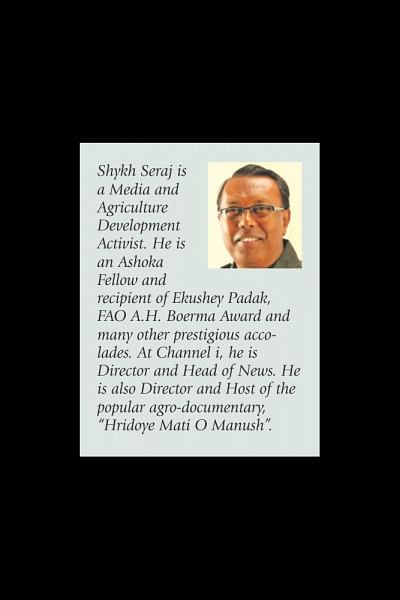Hydroponic grass to meet nutrition needs for livestock

Dear readers, during the past couple of weeks I have been writing articles on the advancements of farming at home and abroad. It's well known that greenhouse technology is expanding and the change is going to make a big impact across the country. This technology is now being used to produce nutritious green grass for livestock animals.
A few days back, I went to Dhaka's BCSIR (Bangladesh Council of Scientific and Industrial Research). They're running a project, titled, 'Centre for Technology Transfer and Innovation', under which grass is being produced on water without soil beneath. This is an experimental project. Those who raise cattle, fatten cows, rear cows for producing milk etc, often depend on grass for feeding the animals. Sometimes they get it easily, sometimes they don't. For the lack of raw (green) grass, the production of milk and meat gets decreased. Many other problems occur. On the other hand, cultivable lands are decreasing gradually. Even though we produce many kinds of Napier grass, now due to the lack of lands, we are not being able to produce what we need. Thus, this project has been brought for producing huge amount of grass in a controlled environment. Moreover, the grass produced by this project contains the highest amount of protein. This grass can be produced from wheat seeds.
For those who are raising cattle or producing grass on lands commercially, this project might be more useful. This is the first-ever initiative of producing grass inside a greenhouse for livestock animals. Today, you'll get to know how they're producing it, using hydroponic culture, in a greenhouse.
I talked with a researcher working inside about the production stages of the grass.
"We use a tray first where the seeds will be soaked with hydrogen peroxide for six to eight hours and we set it the way it is needed for aeration," says the researcher.
"What are these seeds?" I asked.
"We use wheat and barley seeds," he replied.
They are using a modern tray aeration system, but farmers usually do not have these resources.
"What would an ordinary farmer do?" I asked.
"It is possible without aeration as well. However, aeration makes it more complete," he replied.
"Can a farmer use tray?" I asked him.
"Yes, he can but he needs to soak the seeds for six to eight hours," he confidently replied.
“This is mainly used to germinate the seeds. The germination rate is 80%-90%,” says BCSIR's Chief Scientific Officer Rezaul Karim, also director of this project.
"So, what are you going to do with the germinated seeds now?" I asked Rezaul Karim.
"We are going to keep them on different trays for seven days," he replied.
Then, seedlings start growing fast from the germinated seeds. The wheat seedlings start turning green in the controlled environment of the greenhouse. It is a totally pure and nutritious food ingredient for the livestock animals.
Here, each room or chamber has a different stage of the germinated seeds.
Rezaul Karim says that the grass produced here under a controlled environment is more nutritious than any other feed or general grass we see on the vast lands.
Readers, let me tell you, this greenhouse technology and infrastructure has been adopted from an American company named 'FodderTech'. Along with technical support, they have also sent an officer to help run the greenhouse on commercial basis. Russell Black is working here as manager of operations. He explained the multipurpose usage of this greenhouse technology.
You might know that FodderTech Company has been working worldwide for producing modern and nutritious cow feed including hydroponic grass. They think about the agriculture of the future. What is prioritized the most here is the matter of nutritious feed for the livestock.
"We aim to turn the grain seeds to green, fresh and nutritious feed. We create the production systems one by one, through which you can harvest grass throughout the year, every day of the 365 days," says Russell.
"There is no alternative to such project considering the future," adds Russell.

Rezaul Karim says, if the people doing large-scale farming undertake such a project commercially, they will be benefitted in various ways and can also provide assistance to small farmers. Such kind of grass producing system will help boost production of cow milk and meat.
They have imported the nutrient which is adjusted and balanced, consisting 24 different minerals that help the growth of grass and by eating it the animals get the necessary minerals.
Rezaul Karim is working with this project for many days. He pinpointed the project cost details and management.
"How much does this technology cost?" I asked him.
"The big one which can produce 450 kg to 500 kg grass in a day, will cost Tk 7.7 lakh to assemble, including trays and others," he replied.
"And the small one will cost 4.5 lakh taka," added Karim.
"What about the electricity cost?" I asked.
"It needs very small amount of power. We need around 500W in total. We need electricity mainly for the water and the AC. The LED lights run on batteries. So, we don't require much electricity," he replied.
"From every 2.5 kg of grass, we are getting one kg of milk. Moreover, from every four kg of grass, we get one kg of solid meat. It is very clear. It also increases the weight rapidly," says Karim.
Rezaul Karim says, “If you can get certified seed of wheat for 25 taka and the germination rate is 90%, then you're getting 6 kg of grass. You can get maximum 9 kg. This project will run for 5 years.”
They will arrange demonstration. Moreover, they will go for large-scale production so that the cost gets decreased.
"The hydroponic grass is nutritious, safe and hygienic. The grass we see farmers buy or grow in open fields for our animals sometimes causes diarrhoea and other diseases to the animals," pointed out Rezaul.
BCSIR Chairman Faruque Ahmed talks about how much realistic and essential this grass producing greenhouse technology is.
This is for those who commercially produce grass, especially those who have 100-200 cows in their farms.
"Such farmers can invest 4-5 lakh taka for this," says Faruque Ahmed.
"We have targeted industrial entrepreneurs along with some financially well-established large-scale farmers. We need to consider the reality of our country and the financial state of our entrepreneurs and farmers as well," adds Faruque Ahmed.
"We are getting Vitamin A from the top of the grass, at the same time, from the bottom, we are getting Vitamin E. These things altogether makes the reproductive system strong," says the BCSIR chairman.
Dear readers, agriculture based food production system is changing and evolving. Now there is shortage of cultivable lands. On the other hand, there is scope for crop production in a calculated manner in a controlled environment. Already, we can see high activities of greenhouse agriculture in many places of Europe and Asia. In this case, this controlled environment is being considered worldwide for producing nutritious feed for domestic animals. The reason is grazing grounds and natural sources of grass are decreasing day by day due to urbanisation. At the same time, we are expecting high level of cow's meat and milk production. Considering all these, this grass producing greenhouse technology could be a permanent and effective infrastructure. Those who have established large-scale cow farms can take technical support from BCSIR and build such permanent infrastructure. At the same time, the farmers can take this infrastructure as an example and figure out how to decrease the cost, yet produce grass the same way. I hope even that won't be hard for our farmer brothers.

 For all latest news, follow The Daily Star's Google News channel.
For all latest news, follow The Daily Star's Google News channel. 



Comments